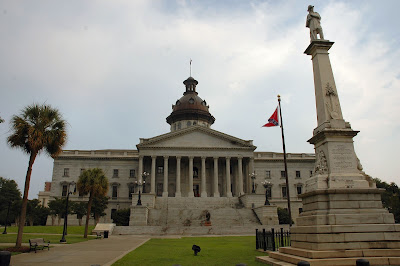State Capitols - Columbia, South Carolina – Interior
I found the Victorian interior of the South Carolina capitol absolutely charming. Major renovations in the late ‘90 have restored color and vitality to the space.
Dominating the lobby between the two legislative chambers is the statue of who else but John C. Calhoun...the same representation that stands in Statuary Hall in the U.S. capitol. The Senator is revered here for his staunch, states’ rights positions. He was the leading voice of the theory of nullification...that quaint notion that states can ignore federal laws they don’t like. A painting of Calhoun is also front-and-center in the Senate chamber. I have never seen a depiction of the guy that wasn’t stern and glaring. I hope he smiled at his wife and kids occasionally.
Behind the statue of Senator Calhoun, the ceiling opens up inside the copula. I do like it when I can stand directly under the center and capture the uniform patterning of the architecture.
The House of Representatives has 124 members. Viewing the front of the room in this picture, you can see a display case on the left side near the globe lamps. It contains a mace. Through history, as public civility improved, the king’s bodyguard…actually armed with a real mace weapon, evolved to become the parliament’s sergeant-at-arms who carried a ceremonial mace as a symbol of the legislature’s authority. Made in London in 1756, the South Carolina mace is the oldest one used in this country.
This handsome room was once the State Library and is the only room in the state house that retains its original condition.
It was great to see the ceremonial removal of the Confederate battle flag from the grounds of the state capitol this month. Congratulations to the elected officials for finally doing the right thing. After all, this is the United States of America.
















